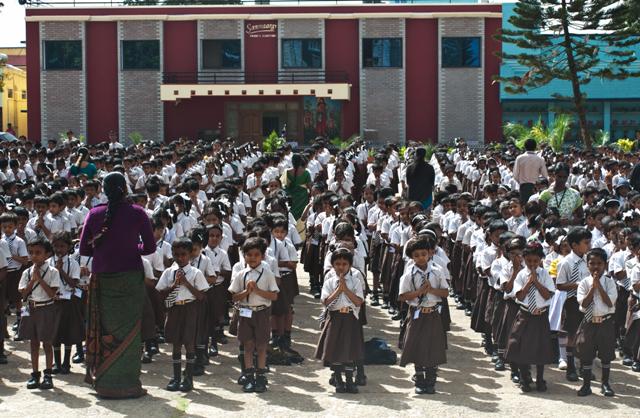 Schoolchildren praying in a schoolyard in Mysore, Karnataka, India. [Photo: Franck Metois / Alamy Stock Photo]
Schoolchildren praying in a schoolyard in Mysore, Karnataka, India. [Photo: Franck Metois / Alamy Stock Photo]
[This is an excerpt from an article in The Round Table: The Commonwealth Journal of International Affairs.]
Since its independence on 15 August 1947, India has come a long way in the following seventy-five years. The nation has made strides forward in every sphere, whether it is the economy, infrastructure, science and technology, or education.
Education has been a significant factor in India’s economic development since 1947. India had already fallen behind on many critical developmental metrics when it gained independence. It was up to the leaders who were active in the liberation struggle to solve the extant problems and devise a strategy for turning India into a modern, educated, and developed nation. After being under colonial control for the previous two centuries, India finally established a planning committee in 1950 to devise a new education system. Since then, they drafted several different plans and the principal goals of these plans included, among other things, the elimination of illiteracy, the achievement of universal elementary education, and the establishment of vocational and skills training programmes. As a result of their efforts, the 27 universities which existed in 1950–51 increased to 1,043 in 2019–20. India also made tremendous strides in other areas of education, including at elementary level, secondary schools and universities, and so on. The various educational institutions founded in the decades following the country’s independence, such as the University Grants Commission, the All-India Council of Technical Education, the Indian Institutes of Technology, and the Indian Institutes of Management, have contributed significantly to India’s rise to the status of a global educational powerhouse.
The education system in India: promises to keep
The expanding role of majoritarianism in India
India at 75 – Special edition of the Round Table Journal
Here are a few facts and data on how the country has progressed in the realm of education over its 75-year history:
Gender equality and the enrolment rate: Female education was not prioritised at the time of independence. The trend was against sending girls to school. However, that has changed. Girls currently outnumber boys in terms of schooling. Compared to 1950–1951, there are currently 1.02 female pupils for every boy enrolled in primary school (classes I–V). In classes VI to VIII (upper primary) had 1.01 more girls than boys.
Literacy rate: India’s literacy rate has increased from 18.3% in 1951 to 74.4% in 2018. The percentage of literate women increased from 8.9 to 65.8.
Number of schools: In independent India, increasing educational possibilities for the public has been a top priority for every administration. The number of schools has increased more than tenfold, from 140,000 lakh at the time of independence to 1.5 million in 2020–21. There has also been a substantial increase in the number of colleges. In the academic year 1950–1951, India had 578 colleges; today, the country has 42,343. Over the past seven decades, the number of medical schools has expanded by more than 21 times.
While India is commemorating its 75th year of independence, it is on the verge of putting its National Education Policy (NEP) 2020 into effect. The New Educational Plan (NEP) 2020 proposes several major reforms, including the use of regional languages as the medium of instruction in schools, the replacement of India’s current 10 + 2 schooling system with a new 5 + 3 + 3 + 4 system, the extension of all graduate programmes to four years, and the standardisation of grading practices across all educational institutions. The plan aims to transform India’s educational system, specifically by making regional languages an accepted medium of instruction in schools. This policy will also pave the way for universities from outside India to play a more prominent role in India. How well the National Education Policy 2020 is implemented will determine India’s future.
Dr. Amit Verma is a Senior Assistant Professor, Journalism & Mass Communication, Directorate of Online Education, Manipal University Jaipur, Jaipur, Rajasthan, India.



